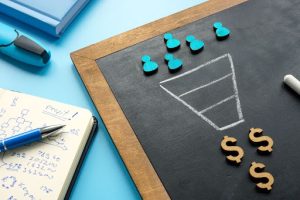Maintaining a full sales pipeline is key to any business’ success. At Ironmark, we believe it’s important to understand the “Buyers’ Journey” from the first point of contact to the sale and beyond. By grasping the prospect’s mindset as they move from one stage to the next, we can better provide the information they need to make their buying decision.
Getting Emotional
As studies have proven, decision-making seems like a logical pursuit—but underlying emotional drivers significantly affect the ultimate choice. By communicating with prospects through every step of their emotional journey along the conversion path, marketers create a win-win. They help prospects find the solution they’ve been seeking and they generate conversions.
What is the Buyer’s Journey?
Known simply as the “lead funnel,” the Buyer’s Journey is a set of steps people usually take when making a decision to purchase a product or service. Depending upon the product or service, it can be a lengthy process (for a car for instance) or very quick (a new brand of shampoo). Regardless, it’s important for marketers to try to connect with prospects along their conversion path in order to make them comfortable enough to make the purchase. This usually requires an omnichannel approach with different touchpoints for every step along the way. Here’s how the journey works—and which lead generation tools are most effective at each stage.
Awareness Stage: This is the point when someone realizes they have an issue or a problem they’re trying to solve. They may be trying to maintain a ten year-old car that is spending more time in the shop than in their driveway. They may be frustrated with their current shampoo because it’s leaving their scalp feeling dry. In this stage, they’ll actively seek out information. Word of mouth is usually the first, most trusted choice. They may ask a friend or acquaintance, or tap a social media group. They may query a search engine for answers, with a “how to” prompt, one of the popular ways to glean information.
Awareness Lead Generation Tools: At this point, prospects are not ready to look for specific companies or solutions. They’re just hoping to understand their problem and put it in context. As a marketer, however, it’s important to have a presence during the Awareness Stage. Positioning yourself as an authority will start to seed your branding early.
There are several ways you can accomplish this:
- Purchase search engine or social media keyword phrases with the words “how to” that are related to the problems your product or service can solve.
- Write blogs that also contain these keywords and show thought leadership in their category.
- Provide more information through videos, whitepapers, webinars, ebooks, how-to’s, checklists, or more to educate and inform them further; include lead generation forms to capture their contact information.
Related: Lead Generation Forms: 8 Examples That Will Actually Get Leads.
Then it’s on to the next lead funnel stage.
Consideration Stage: At this point, the buyer has solidified their issue and given it a name. I need a new car, with room to seat more people and a reputation for good quality. I’m looking for a shampoo that helps fight dandruff. Now, they are seeking solutions, as they dig into the different options to understand their specific benefits. They might ask Google, “Which car lasts longer: a Honda or a Subaru?” or “What are the best dandruff shampoos?” They are starting to deeply explore their next steps and even compare different companies.
Consideration Lead Generation Tools: While prospects are not ready to buy just yet, it’s also important to have a presence during this stage. Here are some ways to help them on the conversion path:
- Purchase keywords that ask the questions they’re asking.
- Offer more information through a blog, website, SEO, social media, article, email, case study, or other channel that states your direct benefits versus your competitors’, or highlights differentiators you can tout.
- Provide free samples so they can become familiar with your product or service.
Remember this stage can last a long time with a big ticket item, so it’s critical to stay engaged and keep the content authentic and not too salesly. Which brings us to the next stage….
Decision Stage: Their minds are mostly made up now, and they’ve gone with a specific solution strategy; now they want to look at the top contenders for their business and make the purchase. They might say “Honda Odyssey or Subaru Forester—which lasts longest?” or “Head and Shoulders vs NizoralⓇ for treated hair?”
Decision Lead Generation Tools: At this point, you’ll want to be in front of them, showing how you can solve their problem easily (better than the competition). Here’s how:
- Send an email addressing their question.
- Set up a website landing page with information and a way to buy your product with a live chat or chatbot.
- Provide a live demo, coupon, or free trial or consultation.
- Focus on reviews! A recent PowerReviews report found more than 99.9 percent of customers read reviews when they shop online. Even those shopping brick and mortar often look online first (or while in the store). These are typically done on Google, Facebook, and Yelp, and you can feature them on your social media accounts and site for added exposure.
Delight Stage! This one is fun. Since repeat customers are the most
cost-effective, staying in touch after the purchase is a critical final step towards cementing brand trust and loyalty. You can delight your customers with the following:
- Give workshops to help people maximize your offerings.
- Provide discounts for future purchases.
- Send newsletters with tips and tricks.
- Give a behind-the-scenes look at your business.
- Send free gifts.
This encourages customers to sing your praises and advocate for your products and services, helping others who are on their own Buyer’s Journey as well!
Related: Implementing Lead Generation Strategies that Work.
Get Started with the Buyer’s Journey
If it seems like a lot of coordination, that’s because it is. Like with any good relationship, a good customer relationship requires time and nurturing. Fortunately, there are lead funnel tools like CRMs and other tracking technology that help monitor which stage prospects are in and what can be helpful in moving them along the continuum.
If you want to connect with your prospects in meaningful ways along their conversion path, you need a marketing firm that can leverage powerful lead generation tools with the nuance and expertise to craft the right messaging needed at the right time. Ironmark is an expert at the Buyer’s Journey and all things marketing strategy. We have helped companies across numerous industries form fruitful lasting relationships with their customers. Want to see how you can harness the Buyer’s Journey to increase your leads? It all starts with awareness.




